 Buckingham
Palace has served as the official London residence of Britain’s Kings
and Queens since 1837. Built by George VI on the site of the King’s
House, Pimlico, the shell of which was preserved by Nash, the
architect. Marble Arch once stood in front, but it was later removed to
the western end of Oxford Street where the famous Tyburn Gallows once
stood. When Queen Victoria moved here in 1837, just 10 years after the
works had been carried out, it was barely habitable. There are 600
rooms in the Palace, of which under twenty can be visited, as well as
the Queen’s Picture gallery and the Mews.
Buckingham
Palace has served as the official London residence of Britain’s Kings
and Queens since 1837. Built by George VI on the site of the King’s
House, Pimlico, the shell of which was preserved by Nash, the
architect. Marble Arch once stood in front, but it was later removed to
the western end of Oxford Street where the famous Tyburn Gallows once
stood. When Queen Victoria moved here in 1837, just 10 years after the
works had been carried out, it was barely habitable. There are 600
rooms in the Palace, of which under twenty can be visited, as well as
the Queen’s Picture gallery and the Mews.
It originated as a town house that was owned from the beginning of the eighteenth century by the Dukes of Buckingham. Today it is The Queen’s official residence. It is regularly on the top ten lists of worse places to visit by those that have, but still draws huge numbers of those that haven’t. Some say that it is a nice place to view from the outside, though the crowds can be horrendous. If the Royal Standard is flying over the palace then the Queen’s in residence.
Although in use for the many official events and receptions held by the Queen, areas of Buckingham Palace are opened to visitors on a regular basis. The Palace is also the venue for great Royal ceremonies, State Visits and Investitures, all of which are organised by the Royal Household. Besides being the official London residence of the Queen, it is also the administrative headquarters of the Monarchy, including the offices of those who support the day-to-day activities and duties of The Queen and The Duke of Edinburgh and their immediate family.
The State Rooms of the Palace are open to visitors during the Annual Summer Opening in August and September. They are lavishly furnished with items from the Royal Collection including paintings by Rembrandt, Rubens, Vermeer, Poussin, Canaletto and Claude; sculpture by Canova and Chantrey; examples of Sèvres porcelain; and some of the finest English and French furniture in the world. Visits to Buckingham Palace can be combined with visits to The Queen’s Gallery, which reopened in May 2002. The nearby Royal Mews is open from 5 March to 31 October 2005.
For those who do receive an invitation to Buckingham Palace, the first step across the threshold is into the Grand Hall and up the curving marble stairs of the Grand Staircase. Portraits are still set in the walls, as they were by Queen Victoria. The Throne Room, sometimes used during Queen Victoria’s reign for Court gatherings and as a second dancing room, is dominated by a huge arch supported by a pair of winged figures of ‘victory’ holding garlands above the ‘chairs of state’. It is in the Throne Room that the Queen, on special occasions like Jubilees, receives loyal addresses. Another use of the Throne Room has been for formal wedding photographs.
George IV’s original palace lacked a large room in which to entertain. Queen Victoria rectified that shortcoming by adding in 1853-5 what was, at the time of its construction, the largest room in London. It is 22 feet long, 60 feet wide and 45 feet high, the Ballroom is the largest multi-purpose room in Buckingham Palace. It was opened in 1856 with a ball to celebrate the end of the Crimean War. The Ballroom has been used variously as a concert hall for memorial concerts and performances of the arts and it is the regular venue for Investitures of which there are usually 21 a year – nine in spring, two in the summer and ten in the autumn. At Investitures, the Queen (or the Prince of Wales as her representative) will meet recipients of British honours and give them their awards, including knighting those who have been awarded knighthoods.
It is along the East Gallery that the Queen and her State guests process to the Ballroom for the State Banquet normally held on the first day of the visit. Around 150 guests are invited and include members of the Royal family, the government and other political leaders, High Commissioners and Ambassadors and prominent people who have trade or other associations with the visiting country. Today, it is used by the Queen for State banquets and other formal occasions such as the annual Diplomatic Reception attended by 1,500 guests. This is a very formal occasion during which The Queen will meet every head of mission accredited to the Court of St James’s. For the diplomats it is perhaps the highlight of the annual diplomatic social calendar.
From the Ballroom, the West Gallery, with its four Gobelin tapestries, leads into the first of the great rooms that overlook lawn and the formal gardens – setting for the annual Garden Parties introduced by Queen Victoria in 1868.
The State Dining Room is one of the principal State Rooms on the West side of the Palace. Many distinguished people have dined in this room including the 24 holders of the Order of Merit as well as presidents and prime ministers.
Before the Ballroom was added to the Palace in the 1850s, the first State Ball was held in the Blue Drawing Room in May 1838 as part of the celebrations leading up to Queen Victoria’s Coronation.
The Music Room was originally known as the Bow Drawing Room and is the centre of the suite of rooms on the Garden Front between the Blue and the White Drawing Rooms.
Four Royal babies – The Prince of Wales, The Princess Royal, The Duke of York and Prince William – were all christened by the Archbishop of Canterbury in the Music Room. One of its more formal uses is during a State Visit when guests are presented to The Queen, The Duke of Edinburgh and the visiting Head of State or for receptions.
The last of the suite of rooms overlooking the gardens on the principal floor is the White Drawing Room. Originally called the North Drawing Room, it is perhaps the grandest of all the State Rooms. The Room also serves as a Royal reception room for The Queen and members of the Royal family to gather before State and official occasions.
The Bow Room is familiar to the many thousands of guests to Royal Garden Parties who pass through it on their way to the garden. It was originally intended as a part of George IV’s private apartments – to be the King’s Library – but it was never fitted up as such. Instead, it has become another room for entertaining and is where The Queen holds the arrival lunch for a visiting Head of State at the start of a State visit.
If you are looking for a job at Buckingham Palace, they are regularly advertised on the official website: https://www.rct.uk/visit/buckingham-palace



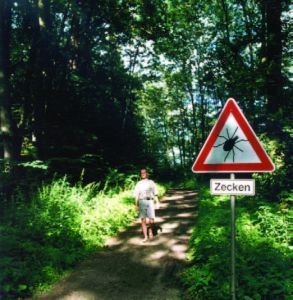 Adventure travel, hiking and mountain biking in Europe are all
increasing in popularity as people discover these new destinations.
Adventure travel, hiking and mountain biking in Europe are all
increasing in popularity as people discover these new destinations.

 We are sorry to
say that Mac is not very well, but he is still e-mailing strong and
recently sent the Beetle a collection of travel reminiscences and
in particular discusses some travel writers. Former Globetrotter
President, Arthur Frommer (Europe On $5 A Day) gave an interesting
interview to travel writer Michael Shapiro for Michael's book,
We are sorry to
say that Mac is not very well, but he is still e-mailing strong and
recently sent the Beetle a collection of travel reminiscences and
in particular discusses some travel writers. Former Globetrotter
President, Arthur Frommer (Europe On $5 A Day) gave an interesting
interview to travel writer Michael Shapiro for Michael's book,
 The gentle
sound of Guitars drifting across the tropical air whether it be in
the market square in the borough of Laranjeiras or by the beach in
Ipanema, introduced me to the sound called “Chorinho” –
The crying or weeping of guitars. The music started about the turn of the 20th century and like jazz is free flowing and improvised. The lead instrument is called a
“Cavaquinho”, a small guitar and the music is always
instrumental in form, but many times has a flute or Sax amongst the
various guitars. The undulating but easy listening rhythm is
controlled by the guitars and usually one tambourine.
“Chorinho” fell out of fashion for a time but seems to be
making a come back, especially on Saturday mornings around the
town, where the musicians gather quite a crowd.
The gentle
sound of Guitars drifting across the tropical air whether it be in
the market square in the borough of Laranjeiras or by the beach in
Ipanema, introduced me to the sound called “Chorinho” –
The crying or weeping of guitars. The music started about the turn of the 20th century and like jazz is free flowing and improvised. The lead instrument is called a
“Cavaquinho”, a small guitar and the music is always
instrumental in form, but many times has a flute or Sax amongst the
various guitars. The undulating but easy listening rhythm is
controlled by the guitars and usually one tambourine.
“Chorinho” fell out of fashion for a time but seems to be
making a come back, especially on Saturday mornings around the
town, where the musicians gather quite a crowd.
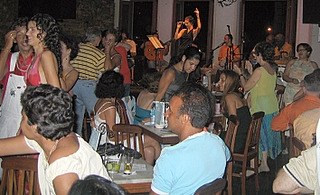 A place not to be missed if you are in Rio is,
“Centro de Cultura do Carioca”. A club or bar in the City
of Rio, near the club land of the district of Lapa, that appeals to
people of all types and ages and has very good Samba, Choarinho,
Popular Brazilian Music and always has a first class group and
singers. 15 R$ (four pounds Sterling) entrance fee and tins of beer
for about 60p each. Caipirinha, a large one costs one pound
fifty.
A place not to be missed if you are in Rio is,
“Centro de Cultura do Carioca”. A club or bar in the City
of Rio, near the club land of the district of Lapa, that appeals to
people of all types and ages and has very good Samba, Choarinho,
Popular Brazilian Music and always has a first class group and
singers. 15 R$ (four pounds Sterling) entrance fee and tins of beer
for about 60p each. Caipirinha, a large one costs one pound
fifty.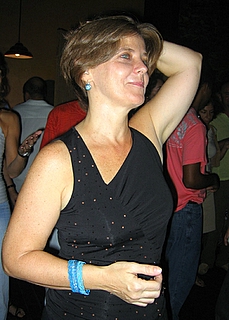
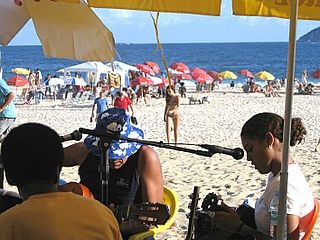 The only tourists, if you could call them that, were
an American Surfing Photographer, who had lived here for four
years, an Argentinean, who had fallen in love, both with Rio and a
girl during Canaval. As the club empted about 3.30 am my friends
and I went to sit by the sea in a district called Leme. A bar
called “Sindicato do Chopp” (Union of the Draft Beers) I
knew it well from a past magazine shoot and there we relaxed and
downed a last drink before that magic hour when the sun rose and my
lovely cool Princess, turned into Sleeping Beauty and I turned back
into a frog.
The only tourists, if you could call them that, were
an American Surfing Photographer, who had lived here for four
years, an Argentinean, who had fallen in love, both with Rio and a
girl during Canaval. As the club empted about 3.30 am my friends
and I went to sit by the sea in a district called Leme. A bar
called “Sindicato do Chopp” (Union of the Draft Beers) I
knew it well from a past magazine shoot and there we relaxed and
downed a last drink before that magic hour when the sun rose and my
lovely cool Princess, turned into Sleeping Beauty and I turned back
into a frog.
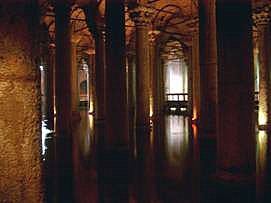
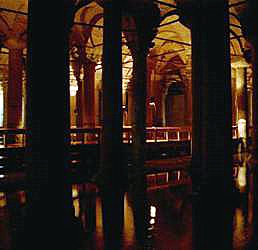
 in the north-western corner, one inverted and the
other on its side; according to mythology, placing her this way
caused her to turn herself into stone. Another theory is that
turning her upside down neutralises her powers. There are some huge
fish too in the water whose function is to aerate the water (and
feed on tourists' handouts). There are signs giving details of
classical concerts that take place in the cisterns. The Basilica
Cistern was restored in 1980 for visitors.
in the north-western corner, one inverted and the
other on its side; according to mythology, placing her this way
caused her to turn herself into stone. Another theory is that
turning her upside down neutralises her powers. There are some huge
fish too in the water whose function is to aerate the water (and
feed on tourists' handouts). There are signs giving details of
classical concerts that take place in the cisterns. The Basilica
Cistern was restored in 1980 for visitors.